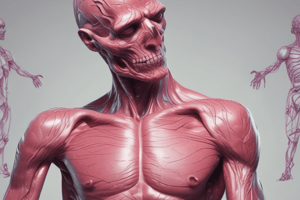Podcast
Questions and Answers
Which level of structural organization is characterized by similar cells working together to perform a specific function?
Which level of structural organization is characterized by similar cells working together to perform a specific function?
- Cellular level
- Organ level
- System level
- Tissue level (correct)
In the anatomical position, which of the following is NOT true?
In the anatomical position, which of the following is NOT true?
- The palms are facing posteriorly. (correct)
- The arms are hanging at the sides.
- The body is erect.
- The feet are together.
If a surgeon makes an incision parallel to the midline of the body, they are cutting along which plane?
If a surgeon makes an incision parallel to the midline of the body, they are cutting along which plane?
- Transverse plane
- Oblique section
- Frontal plane
- Sagittal plane (correct)
Which of the following body cavities contains the heart?
Which of the following body cavities contains the heart?
Which of the following is NOT a primary function of the integumentary system?
Which of the following is NOT a primary function of the integumentary system?
Damage to which organ system could lead to an inability to effectively eliminate metabolic wastes from the blood?
Damage to which organ system could lead to an inability to effectively eliminate metabolic wastes from the blood?
Which type of tissue is responsible for conducting electrical signals throughout the body?
Which type of tissue is responsible for conducting electrical signals throughout the body?
Which type of joint provides the greatest range of motion?
Which type of joint provides the greatest range of motion?
Which type of muscle tissue is responsible for involuntary contractions within the digestive tract?
Which type of muscle tissue is responsible for involuntary contractions within the digestive tract?
Which of the following vessels carries blood away from the heart?
Which of the following vessels carries blood away from the heart?
Flashcards
Human Anatomy
Human Anatomy
The scientific study of the structure of the human body.
Chemical Level
Chemical Level
Atoms combine to form molecules
Tissue Level
Tissue Level
Similar cells and surrounding materials make up...
Anatomical Position
Anatomical Position
Signup and view all the flashcards
Anterior (Ventral)
Anterior (Ventral)
Signup and view all the flashcards
Sagittal Plane
Sagittal Plane
Signup and view all the flashcards
Dorsal Body Cavity
Dorsal Body Cavity
Signup and view all the flashcards
Integumentary System
Integumentary System
Signup and view all the flashcards
Skeletal System
Skeletal System
Signup and view all the flashcards
Nervous System
Nervous System
Signup and view all the flashcards
Study Notes
- Human anatomy is the scientific study of the structure of the human body.
Levels of Organization
- Atoms combine to form molecules at the chemical level.
- Molecules form organelles, such as the nucleus and mitochondria, which make up cells at the cellular level.
- Similar cells and surrounding materials make up tissues at the tissue level.
- Different tissues combine to form organs at the organ level.
- Organs working together to perform specific functions form organ systems at the system level.
- Organ systems working together create the whole organism at the organism level.
Anatomical Position
- The standard anatomical position is a reference point for describing the human body.
- The body is standing erect, facing forward, with feet together, arms hanging at the sides, and palms facing forward.
Anatomical Directions
- Superior (cranial): Toward the head end or upper part of a structure or the body; above.
- Inferior (caudal): Away from the head end or toward the lower part of a structure or the body; below.
- Anterior (ventral): Toward the front of the body; in front of.
- Posterior (dorsal): Toward the back of the body; behind.
- Medial: Toward the midline of the body; on the inner side of.
- Lateral: Away from the midline of the body; on the outer side of.
- Proximal: Closer to the origin of the body part or the point of attachment of a limb to the body trunk.
- Distal: Farther from the origin of a body part or the point of attachment of a limb to the body trunk.
Anatomical Planes
- Sagittal plane: Divides the body into right and left parts.
- Midsagittal (median) plane: Sagittal plane that lies exactly in the midline.
- Frontal (coronal) plane: Divides the body into anterior and posterior parts.
- Transverse (horizontal) plane: Divides the body into superior and inferior parts.
- Oblique section: Cuts made diagonally.
Body Cavities
- Dorsal body cavity: Protects the fragile nervous system organs.
- Cranial cavity: Within the skull and encases the brain.
- Vertebral cavity: Runs through the vertebral column to enclose the spinal cord.
- Ventral body cavity: More anterior and larger than the dorsal cavity.
- Thoracic cavity: Surrounded by the ribs and muscles of the chest.
- Pleural cavities: Each enveloping a lung.
- Mediastinum: Contains the pericardial cavity and surrounds the remaining thoracic organs (esophagus, trachea).
- Pericardial cavity: Encloses the heart.
- Abdominopelvic cavity: Inferior to the thoracic cavity.
- Abdominal cavity: Contains the stomach, intestines, spleen, liver, and other organs.
- Pelvic cavity: Lies within the bony pelvis and contains the urinary bladder, reproductive organs, and rectum.
Integumentary System
- Consists of the skin, hair, nails, and cutaneous glands.
- Functions:
- Protection
- Temperature regulation
- Sensation
- Vitamin D synthesis
- Excretion
Skeletal System
- Consists of bones, cartilage, and ligaments.
- Functions:
- Support
- Movement
- Protection
- Blood cell production
- Mineral storage
Muscular System
- Consists of skeletal muscles.
- Functions:
- Movement
- Posture
- Heat production
Nervous System
- Consists of the brain, spinal cord, nerves, and sensory receptors.
- Functions:
- Control
- Communication
- Coordination
- Sensation
Endocrine System
- Consists of glands that secrete hormones.
- Functions:
- Hormone production
- Regulation of body activities (growth, reproduction, metabolism)
Cardiovascular System
- Consists of the heart, blood vessels, and blood.
- Functions:
- Transport of nutrients, oxygen, and waste products
- Immune response
Lymphatic System
- Consists of lymphatic vessels, lymph nodes, and lymphoid organs.
- Functions:
- Fluid recovery
- Immunity
Respiratory System
- Consists of the lungs, trachea, and associated structures.
- Functions:
- Gas exchange (intake of oxygen and elimination of carbon dioxide)
Digestive System
- Consists of the mouth, esophagus, stomach, intestines, and accessory organs.
- Functions:
- Nutrient breakdown and absorption
- Elimination of waste
Urinary System
- Consists of the kidneys, ureters, urinary bladder, and urethra.
- Functions:
- Waste elimination
- Fluid and electrolyte balance
Reproductive System
- Male: Consists of testes, ducts, and penis.
- Female: Consists of ovaries, uterine tubes, uterus, and vagina.
- Functions:
- Production of offspring
Tissues
- Epithelial tissue: Covers body surfaces and lines body cavities.
- Connective tissue: Supports, connects, and separates different types of tissues and organs in the body.
- Muscle tissue: Contracts to produce movement.
- Nervous tissue: Conducts electrical signals.
Bones
- Long bones: Longer than they are wide (e.g., femur, humerus).
- Short bones: Cube-shaped (e.g., carpals, tarsals).
- Flat bones: Thin, flattened, and usually curved (e.g., skull bones, ribs).
- Irregular bones: Complex shapes (e.g., vertebrae, hip bones).
Joints
- Fibrous joints: Immovable or slightly movable (e.g., sutures of the skull).
- Cartilaginous joints: Slightly movable (e.g., intervertebral discs).
- Synovial joints: Freely movable (e.g., knee, shoulder).
Muscles
- Skeletal muscle: Voluntary, striated.
- Smooth muscle: Involuntary, non-striated.
- Cardiac muscle: Involuntary, striated.
Nerves
- Sensory (afferent) nerves: Carry signals from sensory receptors to the central nervous system.
- Motor (efferent) nerves: Carry signals from the central nervous system to muscles and glands.
- Mixed nerves: Contain both sensory and motor fibers.
Arteries and Veins
- Arteries: Carry blood away from the heart.
- Veins: Carry blood to the heart.
- Capillaries: Tiny vessels where exchange of nutrients and wastes occurs.
Lymph Nodes
- Filter lymph and play a role in the immune system.
Endocrine Glands
- Pituitary gland: Regulates growth and other endocrine glands.
- Thyroid gland: Regulates metabolism.
- Adrenal glands: Produce hormones involved in stress response.
- Pancreas: Regulates blood sugar.
- Ovaries/Testes: Produce sex hormones.
Heart
- Four chambers:
- Right atrium
- Right ventricle
- Left atrium
- Left ventricle
Brain
- Cerebrum: Responsible for higher-level cognitive functions.
- Cerebellum: Coordinates movement and balance.
- Brainstem : Controls basic life functions.
Lungs
- Site of gas exchange (oxygen and carbon dioxide).
Stomach
- Stores food and begins chemical digestion.
Small Intestine
- Completes digestion and absorbs nutrients.
Large Intestine
- Absorbs water and forms feces.
Kidneys
- Filter blood and produce urine.
Studying That Suits You
Use AI to generate personalized quizzes and flashcards to suit your learning preferences.





